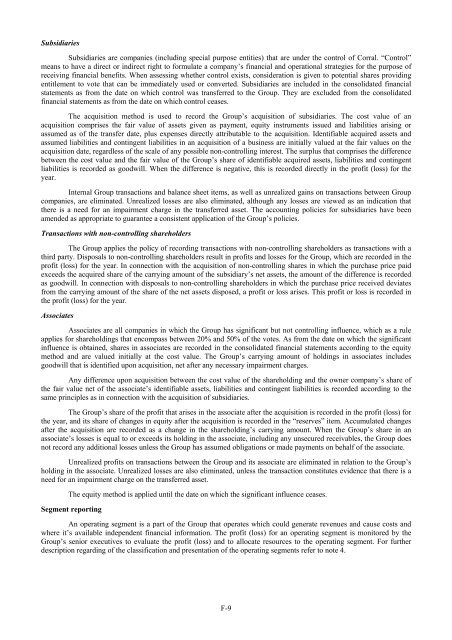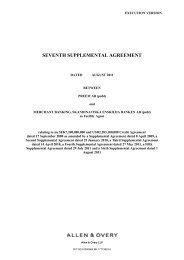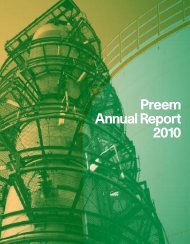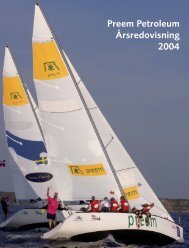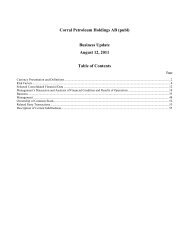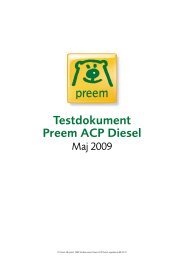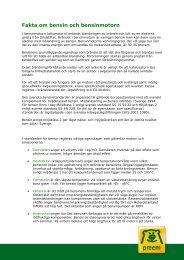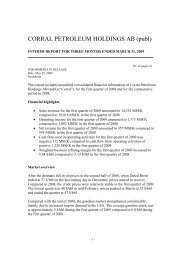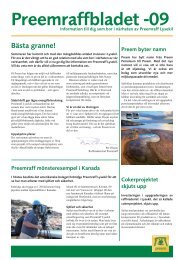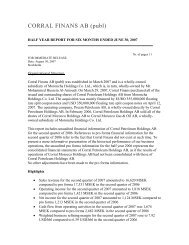CORRAL PETROLEUM HOLDINGS AB (PUBL) - Preem
CORRAL PETROLEUM HOLDINGS AB (PUBL) - Preem
CORRAL PETROLEUM HOLDINGS AB (PUBL) - Preem
You also want an ePaper? Increase the reach of your titles
YUMPU automatically turns print PDFs into web optimized ePapers that Google loves.
SubsidiariesSubsidiaries are companies (including special purpose entities) that are under the control of Corral. “Control”means to have a direct or indirect right to formulate a company’s financial and operational strategies for the purpose ofreceiving financial benefits. When assessing whether control exists, consideration is given to potential shares providingentitlement to vote that can be immediately used or converted. Subsidiaries are included in the consolidated financialstatements as from the date on which control was transferred to the Group. They are excluded from the consolidatedfinancial statements as from the date on which control ceases.The acquisition method is used to record the Group’s acquisition of subsidiaries. The cost value of anacquisition comprises the fair value of assets given as payment, equity instruments issued and liabilities arising orassumed as of the transfer date, plus expenses directly attributable to the acquisition. Identifiable acquired assets andassumed liabilities and contingent liabilities in an acquisition of a business are initially valued at the fair values on theacquisition date, regardless of the scale of any possible non-controlling interest. The surplus that comprises the differencebetween the cost value and the fair value of the Group’s share of identifiable acquired assets, liabilities and contingentliabilities is recorded as goodwill. When the difference is negative, this is recorded directly in the profit (loss) for theyear.Internal Group transactions and balance sheet items, as well as unrealized gains on transactions between Groupcompanies, are eliminated. Unrealized losses are also eliminated, although any losses are viewed as an indication thatthere is a need for an impairment charge in the transferred asset. The accounting policies for subsidiaries have beenamended as appropriate to guarantee a consistent application of the Group’s policies.Transactions with non-controlling shareholdersThe Group applies the policy of recording transactions with non-controlling shareholders as transactions with athird party. Disposals to non-controlling shareholders result in profits and losses for the Group, which are recorded in theprofit (loss) for the year. In connection with the acquisition of non-controlling shares in which the purchase price paidexceeds the acquired share of the carrying amount of the subsidiary’s net assets, the amount of the difference is recordedas goodwill. In connection with disposals to non-controlling shareholders in which the purchase price received deviatesfrom the carrying amount of the share of the net assets disposed, a profit or loss arises. This profit or loss is recorded inthe profit (loss) for the year.AssociatesAssociates are all companies in which the Group has significant but not controlling influence, which as a ruleapplies for shareholdings that encompass between 20% and 50% of the votes. As from the date on which the significantinfluence is obtained, shares in associates are recorded in the consolidated financial statements according to the equitymethod and are valued initially at the cost value. The Group’s carrying amount of holdings in associates includesgoodwill that is identified upon acquisition, net after any necessary impairment charges.Any difference upon acquisition between the cost value of the shareholding and the owner company’s share ofthe fair value net of the associate’s identifiable assets, liabilities and contingent liabilities is recorded according to thesame principles as in connection with the acquisition of subsidiaries.The Group’s share of the profit that arises in the associate after the acquisition is recorded in the profit (loss) forthe year, and its share of changes in equity after the acquisition is recorded in the “reserves” item. Accumulated changesafter the acquisition are recorded as a change in the shareholding’s carrying amount. When the Group’s share in anassociate’s losses is equal to or exceeds its holding in the associate, including any unsecured receivables, the Group doesnot record any additional losses unless the Group has assumed obligations or made payments on behalf of the associate.Unrealized profits on transactions between the Group and its associate are eliminated in relation to the Group’sholding in the associate. Unrealized losses are also eliminated, unless the transaction constitutes evidence that there is aneed for an impairment charge on the transferred asset.The equity method is applied until the date on which the significant influence ceases.Segment reportingAn operating segment is a part of the Group that operates which could generate revenues and cause costs andwhere it’s available independent financial information. The profit (loss) for an operating segment is monitored by theGroup’s senior executives to evaluate the profit (loss) and to allocate resources to the operating segment. For furtherdescription regarding of the classification and presentation of the operating segments refer to note 4.F-9


